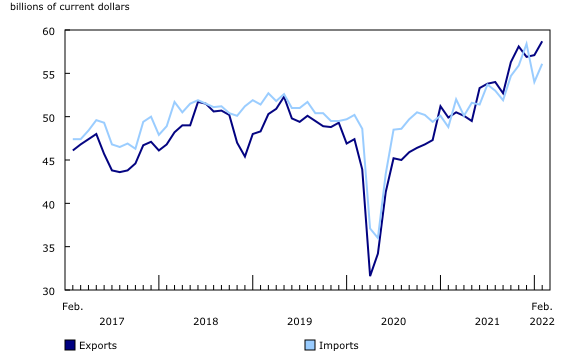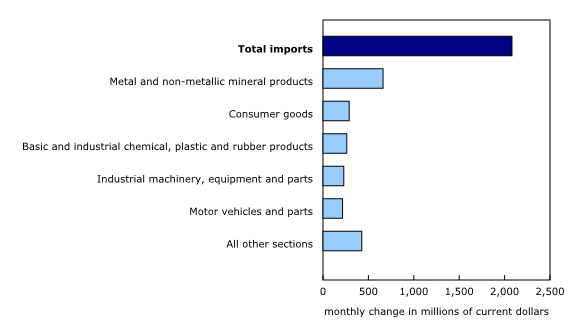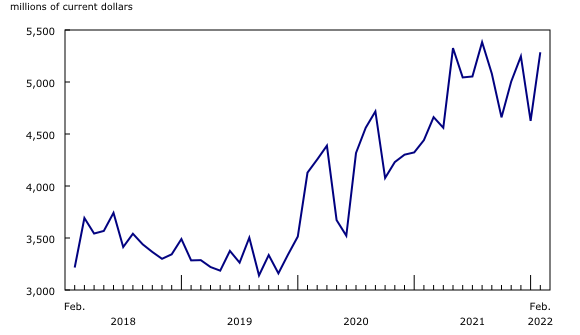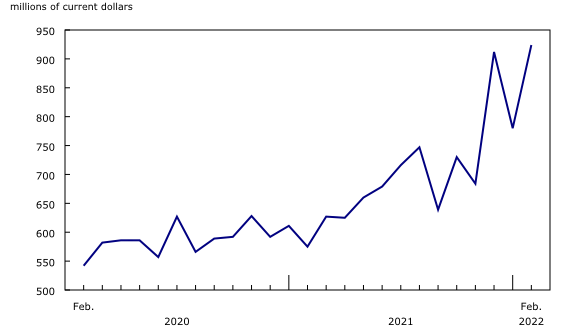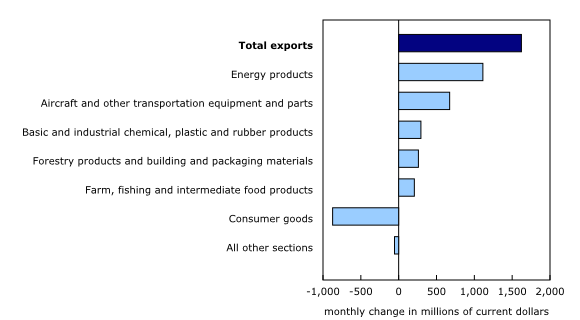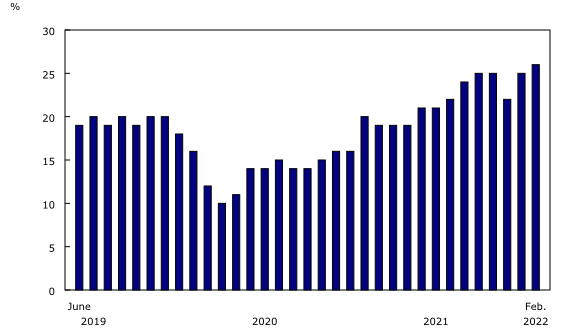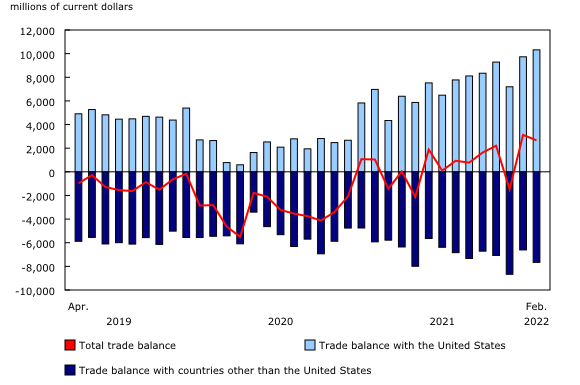Canadian international merchandise trade, February 2022
Archived Content
Information identified as archived is provided for reference, research or recordkeeping purposes. It is not subject to the Government of Canada Web Standards and has not been altered or updated since it was archived. Please "contact us" to request a format other than those available.
Released: 2022-04-05
In February, Canada's merchandise imports were up 3.9%, following a 7.5% decline in January. Meanwhile, exports rose 2.8% in February, largely due to higher exports of energy products. As a result, Canada's merchandise trade surplus with the world narrowed from $3.1 billion in January to $2.7 billion in February.
Consult the "International trade monthly interactive dashboard" to explore the most recent results of Canada's international trade in an interactive format.
Metal products tops widespread increases in total imports
Total imports rose 3.9% to $56.1 billion in February. This monthly increase offsets almost half of the sharp decline (-7.5%) observed in January. Gains were observed in 9 of 11 product sections, with 8 of them posting increases of more than $100 million. In real (or volume) terms, total imports rose 2.0% in February.
After falling 11.8% in January, imports of metal and non-metallic mineral products (+14.3%) posted the largest gain in February, largely due to a widespread increase in imports of intermediate metal products. These imports have been trending upward for some time, and uncertainty about the future supply of metals from Russia may have contributed to the gain in February. Imports of basic and semi-finished products of non-ferrous metals and non-ferrous metal alloys (+74.8%), a category that includes many types of metals, posted the sharpest gain in February, driven mainly by higher imports of copper and palladium.
Imports of consumer goods rose 2.5% in February, mainly on rising prices. Import values for clothing, footwear and accessories (+13.6%) increased the most in February. Imports for this product category have been unstable over the past two years, as the COVID-19 pandemic and constraints on international transportation disrupted the typical trends, resulting in greater monthly variations on a seasonally adjusted basis.
Imports of basic and industrial chemical, plastic and rubber products rose 5.6% in February, in part due to higher imports of fertilizers, pesticides and other chemical products (+18.4%), which reached a record high. A multitude of events have affected this industry recently, including lower production in China, new quotas on fertilizer exports from Russia and the conflict in Ukraine. These events create uncertainty about the availability and the cost of these products, resulting in atypical movements for Canadian fertilizer imports.
Large gains were also observed in other product sections in February. Imports of industrial machinery, equipment and parts increased 3.9%, partially due to higher imports of parts of industrial machinery and equipment (+8.5%). Imports of motor vehicles and parts were up 2.8%, driven entirely by higher imports of motor vehicle engines and parts (+19.8%).
Energy products make up more than two-thirds of the increase in total exports
In February, total exports increased 2.8% to a record $58.7 billion. Overall, there were increases in 8 of 11 product sections, with each gain topping $100 million. Exports of non-energy products rose 1.2% in February. Prices continued to play an important role in the monthly growth of exports. Exports in real (or volume) terms increased by 0.6% in February.
Exports of energy products rose 7.8% to a record $15.4 billion in February. Energy products accounted for 26.2% of total exports in February, an increase of more than 6 percentage points from the share of 19.7% observed in February 2021. Exports of crude oil (+9.9%) contributed the most to the growth in February 2022, largely due to higher prices. As mentioned in the publication of February 2022 data for the Industrial Product Price Index, the imbalance between supply and demand that has persisted for several months, in addition to the uncertainty surrounding the future supply of crude oil due to rising tensions between Russia and Ukraine in late February, is among the causes of the increase in crude oil prices. The volume of crude oil exports increased 3.9% in February, following a decrease of 6.5% in January.
After declining 32.9% in January, exports of aircraft and other transportation equipment and parts rebounded 54.0% in February. Exports of aircraft more than tripled in February, in large part due to higher exports of private jets and commercial aircraft. The increase in aircraft exports in February (+$573 million) more than offset the decrease registered in January (-$542 million).
The decline in exports of consumer goods (-11.4%) moderated the increases in February. After posting record highs in the previous three months, exports of pharmaceutical products (-47.5%) returned to more typical levels in February. In November 2021, large quantities of COVID-19 medication were imported into Canada for packaging and labelling. The medication was then exported in November and December 2021 and in January 2022, which helped boost pharmaceutical exports during this period.
Imports from China rise sharply
Imports from countries other than the United States rose 10.8% in February. China (+26.9%) had the strongest growth by far. Many products contributed to this increase, including imports of pharmaceutical products (COVID-19 testing kits). In addition, imports from China usually decrease as a result of Chinese New Year. This year, however, despite the holiday occurring in early February, imports from this country increased, which led to a sharp rise on a seasonally adjusted basis.
Exports to countries other than the United States were up 8.1% in February. Many countries contributed to this gain, including India (aircraft), Brazil (potash), Taiwan (coal), China (various products) and Italy (pharmaceutical products and crude oil).
Canada's trade deficit with countries other than the United States widened from $6.6 billion in January to $7.7 billion in February.
Canada records its largest trade surplus with the United States since 2005
Exports to the United States rose 1.3% in February, while imports from the United States edged down 0.1%. As a result, Canada's trade surplus with the United States widened from $9.7 billion in January to $10.3 billion in February. This was the largest trade surplus with the United States since December 2005.
When the average exchange rates of January and February are compared, the Canadian dollar depreciated 0.6 US cents relative to the American dollar.
Trade information related to recent events
International trade data can help provide contextual information on recent events in Canada and around the world.
Blockades at border crossings
In late January and February 2022, some border crossings between Canada and the United States were blocked by protesters, preventing the normal flow of goods between the two countries. According to Statistics Canada data, when combined, Canada's highway border crossings at the Ambassador Bridge (Ontario), Coutts (Alberta), Emerson (Manitoba), and the Pacific Highway (British Columbia) represent more than one-third of Canada's trade activity by road. Road transport accounts for more than half of Canada's trade with the United States.
In customs basis figures for February, trade activity by road transport at these border crossings fell 8.8% compared with February 2021, with the Ambassador Bridge and Coutts crossings posting the largest declines. However, increased trade activity was observed at other crossings near the ones that were blocked, partly offsetting the decline in traffic. Overall, the blocked border crossings appear to have had little impact on the aggregate values of Canadian imports and exports in February.
Canada's trade relationship with Russia and Ukraine
Canada has responded to Russia's aggression against Ukraine by imposing further restrictions on trade with Russia. According to The International Trade Explorer, total trade (exports plus imports) with Russia was $2.8 billion in 2021, representing 0.2% of Canadian trade activity. Meanwhile, total trade with Ukraine in 2021 was $447 million.
As a result, the direct impact of the various trade sanctions imposed by a number of countries against Russia should be minimal for Canadian merchandise trade values. However, because Russia produces goods that are also produced in large quantities in Canada (crude oil, natural gas, grains, lumber, metals, fertilizer, etc.), export values could be indirectly affected by higher demand and substantial price increases, given the consequences of the conflict on the future supply of these goods.
Revisions to January merchandise export and import data
Imports in January, originally reported at $54.0 billion in the previous release, were essentially unchanged in the current month's release. Exports in January, originally reported at $56.7 billion in the previous release, were revised to $57.1 billion in the current month's release.
Monthly trade in services
In February, monthly service exports rose 2.8% to $11.6 billion. Service imports edged up 0.1% to $11.9 billion.
When international trade in goods and international trade in services were combined, exports increased 2.8% to $70.4 billion in February, while imports were up 3.2% to $68.0 billion. As a result, Canada's trade surplus with the world went from $2.5 billion in January to $2.3 billion in February.
Note to readers
Merchandise trade is one component of Canada's international balance of payments (BOP), which also includes trade in services, investment income, current transfers, and capital and financial flows.
International trade data by commodity are available on both a BOP and a customs basis. International trade data by country are available on a customs basis for all countries and on a BOP basis for Canada's 27 principal trading partners (PTPs). The list of PTPs is based on their annual share of total merchandise trade—imports and exports—with Canada in 2012. BOP data are derived from customs data by adjusting for factors such as valuation, coverage, timing and residency. These adjustments are made to conform to the concepts and definitions of the Canadian System of National Accounts.
For a conceptual analysis of BOP-based data versus customs-based data, see "Balance of Payments trade in goods at Statistics Canada: Expanding geographic detail to 27 principal trading partners."
For more information on these and other macroeconomic concepts, see the Methodological Guide: Canadian System of Macroeconomic Accounts (13-607-X) and the User Guide: Canadian System of Macroeconomic Accounts (13-606-G).
The data in this release are on a BOP basis and are seasonally adjusted. Unless otherwise stated, values are expressed in nominal terms, or current dollars. References to prices are based on aggregate Paasche (current-weighted) price indexes (2012=100). Movements within aggregate Paasche prices can be influenced by changes in the share of values traded for specific goods, with sudden shifts in trading patterns—as observed currently with the COVID-19 pandemic—sometimes resulting in large movements in Paasche price indexes. Volumes, or constant dollars, are calculated using the Laspeyres formula (2012=100), unless otherwise stated.
For information on seasonal adjustment, see Seasonally adjusted data – Frequently asked questions.
Revisions
In general, merchandise trade data are revised on an ongoing basis for each month of the current year. Current-year revisions are reflected in both the customs-based and the BOP-based data.
The previous year's customs-based data are revised with the release of data for the January and February reference months, and thereafter on a quarterly basis. The previous two years of customs-based data are revised annually, and revisions are released in February with the December reference month.
The previous year's BOP-based data are revised with the release of data for the January, February, March and April reference months. To remain consistent with the Canadian System of Macroeconomic Accounts, revisions to BOP-based data for previous years are released annually in December with the October reference month.
Factors influencing revisions include the late receipt of import and export documentation, incorrect information on customs forms, the replacement of estimates produced for the energy section with actual figures, changes in merchandise classification based on more current information, and changes to seasonal adjustment factors. The seasonal adjustment parameters are reviewed and updated annually, and applied with the October reference month release.
For information on data revisions for exports of energy products, see Methodology for Exports of Energy Products within the International Merchandise Trade Program.
Revised data are available in the appropriate tables.
Real-time data table
The real-time data table 12-10-0120-01 will be updated on April 19.
Next release
Data on Canadian international merchandise trade for March will be released on May 4.
Products
The product "International trade monthly interactive dashboard" (71-607-X) is now available. This new interactive dashboard is a comprehensive analytical tool that presents monthly changes in Canada's international merchandise trade data on a balance-of-payments basis, fully supporting the information presented every month in the Daily release.
The product "The International Trade Explorer" (71-607-X) is now available online.
The Canadian International Merchandise Trade online database is no longer available. It has been replaced by the Canadian International Merchandise Trade Web Application (71-607-X), a modern tool that provides trade data users with a number of enhancements.
The updated "Canada and the World Statistics Hub" (13-609-X) is now available online. This product illustrates the nature and extent of Canada's economic and financial relationship with the world using interactive charts and tables. It provides easy access to information on trade, investment, employment and travel between Canada and a number of countries, including the United States, the United Kingdom, Mexico, China, Japan, Belgium, Italy, the Netherlands and Spain.
Contact information
For more information, or to enquire about the concepts, methods or data quality of this release, contact us (toll-free 1-800-263-1136; 514-283-8300; infostats@statcan.gc.ca) or Media Relations (statcan.mediahotline-ligneinfomedias.statcan@statcan.gc.ca).
- Date modified:



